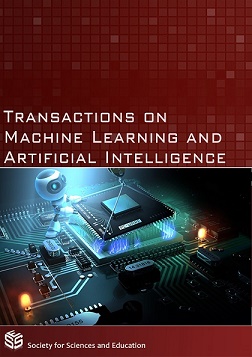Implementation and Comparison of Machine Learning Algorithms for Recognition of Fingerspelling in Indian Sign Language
DOI:
https://doi.org/10.14738/tmlai.55.3557Keywords:
Gesture Recognition, SVM, KNN, ANBC, Edge Frequency.Abstract
Communication is the biggest hurdle faced by the hearing and speech impaired in leading a normal life. In this context, Sign Language is the most prominent means of communication. Machine learning and Computer Vision is an integral part of today’s computing world. This research paper proposes a Machine Learning based system to recognize fingerspelling gestures present in Indian Sign Language. Edge Frequency technique is chosen for Feature Extraction. The system was implemented using Aforge.NET framework. A comparative analysis of the Machine Learning Algorithms consisting of Support Vector Machine (SVM), K- Nearest Neighbor (KNN), Adaptive Naïve Bayes Classifier (ANBC), Decision Tree (DT) and Random Forests (RF) is performed to find out which algorithm is the most suitable to recognize ISL. Comparison is done based on validation accuracies and confusion matrices obtained. The accuracy for KNN was found to be 97.44% while SVM and ANBC have an accuracy of 96.15% and 82.05% respectively.
References
(1) M Miller, "Sound of Silence". Presidential Leadership Academy. April 2016.
(2) S Nair, "Coming soon: First-of-its-kind Indian sign language dictionary" The Indian Express, January 23, 2017. [Online]. Available: http://www.indianexpress.com [Accessed June 18, 2017]
(3) Adithya, P. R. Vinod and U. Gopalakrishnan, "Artificial neural network based method for Indian sign language recognition," Information & Communication Technologies (ICT), 2013 IEEE Conference on, JeJu Island, 2013, pp. 1080-1085
(4) Ningxia Zhang, Yongqing Yuan, “Phishing Detection Using Neural Network”, May 2012.
(5) Austin Sousa, Rasoul Kabirzadeh, Patrick Blaes, “Automatic Colorization of Grayscale Images”, June 2013.
(6) David Harwath, Nikhil Johri, Edouard Yin, “An Unsupervised Approach To Email Label Suggestions”, November 2010.
(7) Charles Burlin, Matthew Crème, Raphael Lenain, “Music Genre Classification”, December 2016.
(8) Satish Kumar Kotha, Jahnavi Pinjala, Kavya Kasoju, Manvitha Pothineni, “GESTURE RECOGNITION SYSTEM”, International Journal of Research in Engineering and Technology, May 2015
(9) Ketki P. Kshirsagar, “Key Frame Selection for One-Two Hand Gesture Recognition with HMM”, June 2015.
(10) Pujan Ziaie, Thomas Muller, Mary Ellen Foster, and Alois Knoll, “A Naïve Bayes Classifier with Distance Weighting for Hand-Gesture Recognition”, Communications in Computer and Information Science Conference, September 2008.
(11) A. Albiol, L. Torress, E. J. Delp, “OPTIMUM COLOR SPACES FOR SKIN DETECTION”. Proc. Of International Conference on Image Processing, Vol. 1, 122-124, 2001.
(12) Ahmed Elgammal, Crystal Muang and Dunxu Hu, “Skin Detection - a Short Tutorial”, Encyclopedia of Biometrics by Springer-Verlag Berlin Heidelberg 2009.
(13) R. Fisher, S. Perkins, A. Walker and E. Wolfart., "Morphology - Closing", Homepages.inf.ed.ac.uk, 2017. [Online]. Available: https://homepages.inf.ed.ac.uk/rbf/HIPR2/close.htm.
(14) M Sharma, S Singh, “Evaluation of Texture Methods for Image Analysis”, Seventh Australian and New Zealand Intelligent Information System Conference, 18th November 2001.
(15) Anita Jadhav, Rohit Asnani, Rolan Crasto, Omprasad Nilange, Anamol Ponkshe, “Gesture Recognition Using Support Vector Machine”. International Journal of Electrical, Electronics and Data Communication. May 2015
(16) Docs.opencv.org, (2017). Introduction to Support Vector Machines — OpenCV 2.4.13.2 documentation [Online]. Available: http://docs.opencv.org/2.4/doc/tutorials/ml/introduction_to_svm
/introduction_to_svm.html.
(17) S. Nagarajan, T. S. Subahini, “Image Based Hand Gesture Recognition using Statistical Features and Soft Computing Techniques”. International Journal of Emerging Technology and Advanced Engineering. July 2015.
(18) Hector Hugo Avilts-Aniaga, Luis Enrique Sucart, Carlos Eduardo Mendozaz, “Visual Recognition of Gestures using Dynamic Naïve Bayesian Classifiers”, November 2003.






